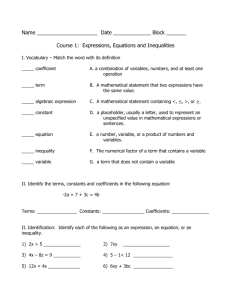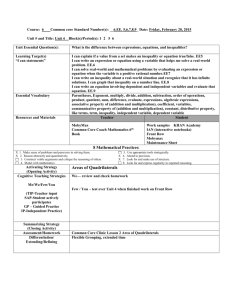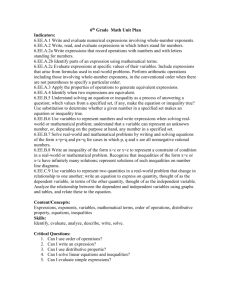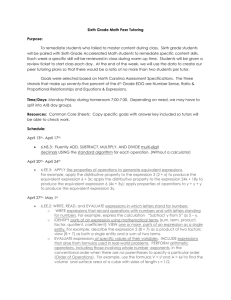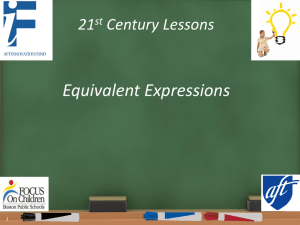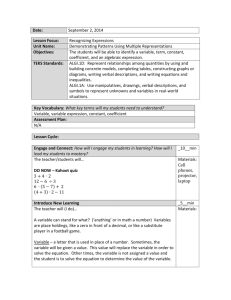Math 6
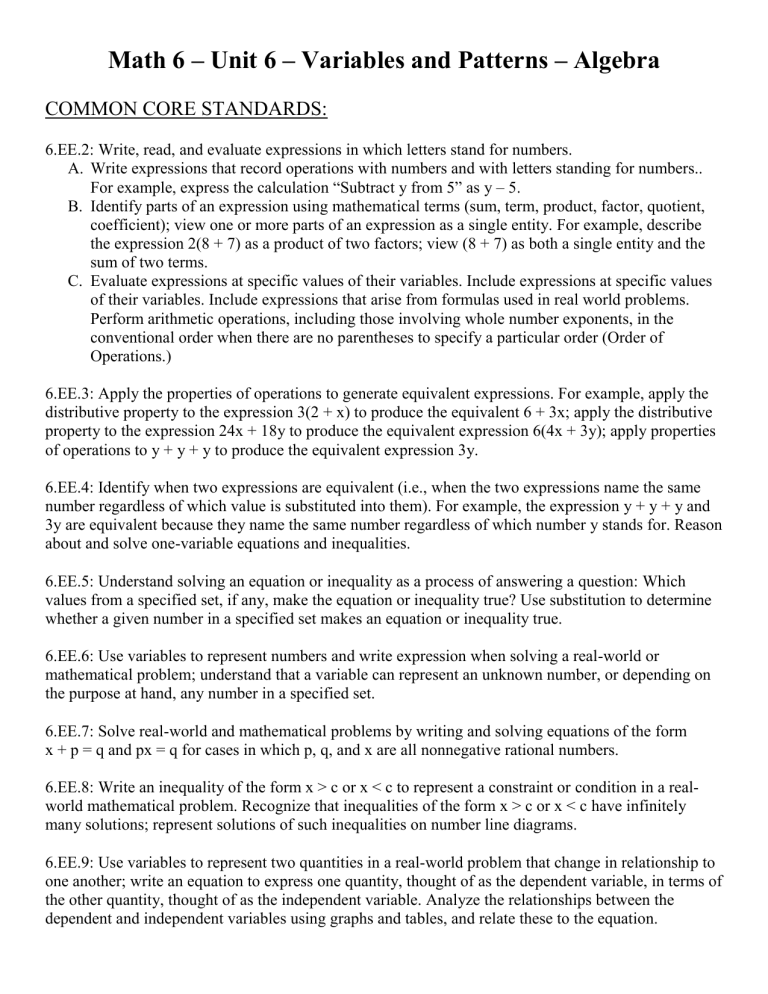
Math 6 – Unit 6 – Variables and Patterns – Algebra
COMMON CORE STANDARDS:
6.EE.2: Write, read, and evaluate expressions in which letters stand for numbers.
A.
Write expressions that record operations with numbers and with letters standing for numbers..
For example, express the calculation “Subtract y from 5” as y – 5.
B.
Identify parts of an expression using mathematical terms (sum, term, product, factor, quotient, coefficient); view one or more parts of an expression as a single entity. For example, describe the expression 2(8 + 7) as a product of two factors; view (8 + 7) as both a single entity and the sum of two terms.
C.
Evaluate expressions at specific values of their variables. Include expressions at specific values of their variables. Include expressions that arise from formulas used in real world problems.
Perform arithmetic operations, including those involving whole number exponents, in the conventional order when there are no parentheses to specify a particular order (Order of
Operations.)
6.EE.3: Apply the properties of operations to generate equivalent expressions. For example, apply the distributive property to the expression 3(2 + x) to produce the equivalent 6 + 3x; apply the distributive property to the expression 24x + 18y to produce the equivalent expression 6(4x + 3y); apply properties of operations to y + y + y to produce the equivalent expression 3y.
6.EE.4: Identify when two expressions are equivalent (i.e., when the two expressions name the same number regardless of which value is substituted into them). For example, the expression y + y + y and
3y are equivalent because they name the same number regardless of which number y stands for. Reason about and solve one-variable equations and inequalities.
6.EE.5: Understand solving an equation or inequality as a process of answering a question: Which values from a specified set, if any, make the equation or inequality true? Use substitution to determine whether a given number in a specified set makes an equation or inequality true.
6.EE.6: Use variables to represent numbers and write expression when solving a real-world or mathematical problem; understand that a variable can represent an unknown number, or depending on the purpose at hand, any number in a specified set.
6.EE.7: Solve real-world and mathematical problems by writing and solving equations of the form x + p = q and px = q for cases in which p, q, and x are all nonnegative rational numbers.
6.EE.8: Write an inequality of the form x > c or x < c to represent a constraint or condition in a realworld mathematical problem. Recognize that inequalities of the form x > c or x < c have infinitely many solutions; represent solutions of such inequalities on number line diagrams.
6.EE.9: Use variables to represent two quantities in a real-world problem that change in relationship to one another; write an equation to express one quantity, thought of as the dependent variable, in terms of the other quantity, thought of as the independent variable. Analyze the relationships between the dependent and independent variables using graphs and tables, and relate these to the equation.
STUDENT LEARNING TARGETS:
1.
I can translate between written phrases and algebraic expressions.
2.
I can identify parts of an algebraic or numerical expression using mathematical terms.(sum, term, product, factor, quotient, coefficient).
3.
I can substitute specific values for variables to evaluate algebraic expressions.
4.
I can write equivalent expressions using the distributive property and combining like terms.
5.
I can determine if two expressions are equivalent.
6.
I can prove that two expressions are equivalent no matter what number is substituted.
7.
I can determine from a set of numbers, which value makes an equation or inequality true.
8.
I can substitute a given number for a variable in an equation or an inequality to determine if it is a solution.
9.
I can write an expression, equation, or inequality for real-world mathematical problems containing one unknown.
10.
I can define inverse operations.
11.
I can solve one-variable equations using inverse operations.
12.
I can graph solutions to an inequality on a number line.
13.
I can define and give examples of independent and dependent variables.
14.
I can write an equation to express one quantity (dependent) in terms of the other quantity
(independent).
15.
I can analyze the relationship between dependent and independent variables using tables and graphs.
16.
I can identify the equation being represented in a table or graph.
VOCABULARY:
Numerical Expression
Algebraic Expression
Coefficient
Product
Sum
Term
Order of Operations
Variable
Equation
Equivalent Expressions
Like Terms
Substitute
Inequality
Unknown
Inverse Operations
Solution
Independent Variable
Dependent Variable
